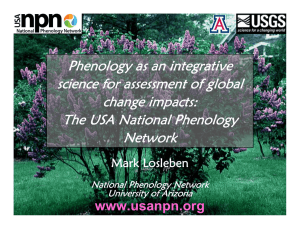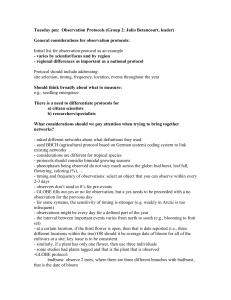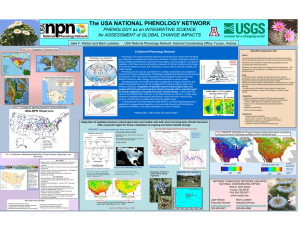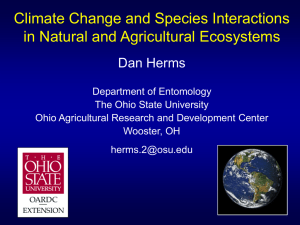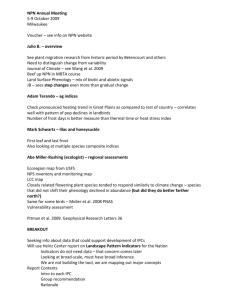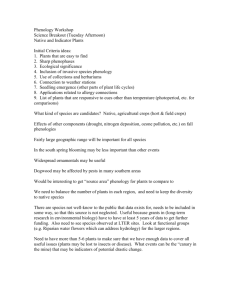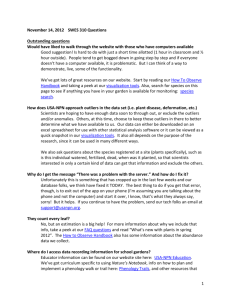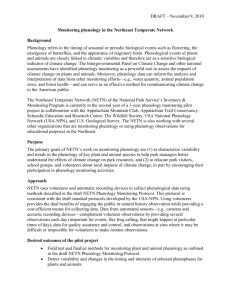Questions that NPN data can address
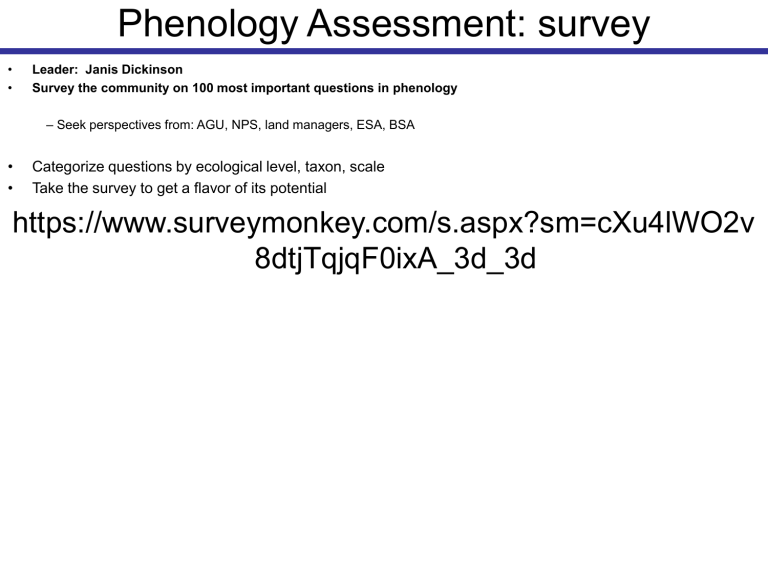
Phenology Assessment: survey
• Leader: Janis Dickinson
• Survey the community on 100 most important questions in phenology
– Seek perspectives from: AGU, NPS, land managers, ESA, BSA
• Categorize questions by ecological level, taxon, scale
• Take the survey to get a flavor of its potential
https://www.surveymonkey.com/s.aspx?sm=cXu4lWO2v
8dtjTqjqF0ixA_3d_3d
Phenology Assessment: data discovery
• Provide descriptions of available data sets for plants and animals
– insect data: population and community level, snapshot and longer-term (state agencies, individual researchers)
– pollinator phenology
– insect pest phenology (Alexander Leibhold [www.sandyliebhold.com; Penn State]: pine beetles, cicadas, mayfly, stonefly;
Barbara Peckarsky [Madison, WI])
– honey yield
– Plant data: First priority: long-term data (particularly for communities or multiple species); Second priority: short-term or snap-shot (community or population)
– herbarium data: identify particularly well-represented data
– National Park Service data mining
– Forest inventory and analysis program (FIA)
– Evaluation of Bill Michener’s Ecological Metadata resource: which data sets are tagged for phenology (Janis Dickinson wrote to Mark Stromberg)
– Avian Knowledge Network
– Climatic variables at different spatial scales
• Map their geographic distributions
•
Provide standardized metadata parameters : frequency of data collection, duration of collection, number of species or populations, parameters
– Location (GPS), elevation; caveat: this will be difficult with wide-ranging taxa
– Type of habitat (vegetation type)
– Duration
– Contact
– Phenophases
– Access
– Pointer if on line
– Metadata file upload
– Taxon/Taxa
– Format
– Number of records
Phenology Assessment: review paper
• Review of evidence for phenological change in U.S.
• For each study, would want to report/compile, for wild plants and animals
– Location, geographic range
– Start and end date of observations
– Taxa/species
– Phenophases studied
– Mean and variance in phenological event
– Change over time
– Relationship of phenological transitions or events to climatic variables
– Status/location of data (sought from investigators)
Summarize questions of general interest that should be pursued
Suggest for future research: investigators should seek and analyze the following data sets to identify temporal patterns:
– Agricultural disease outbreaks
– Mammalian diseases: Hanta virus, Lyme disease, avian flue, West Nile virus
– Game records
– Annual crops
–
Honey yield
– Tree crops
– Wild animals
– Wild plants
– Meta-analysis
Phenology Assessment: review paper
Primary Goal : Review of evidence for phenological change in U.S.; Restrict studies to those of > 15 years duration
Secondary Goal: Identify most important and useful parameters with which to detect phenological change for each taxon or guild
•
Wild plant communities (Isaac Park and Theresa Crimmins)
•
Agricultural disease (Karen Garrett, KSU; emerald ash borer; pine beetle)
•
Forest Inventory and Analysis: Angie Evenden: check for Forest Tree disease/pests (also State departments, IPM)
•
Forest trees/common gardens: Jonathan Friedman (National Forest Service)
•
Pollinators (Laura Berkel, David Inouye, Wayne Esias; Logan, Utah, Tucson, AZ); check out participants in North American
Pollinator Protection Campaign (NAPPC) meeting in two weeks
• Insects (herbivorous, predatory: Laura Berkel: she’s working on David Robertson’s1800’s data set from Illinois; read Waser’s paper in Ecology Letters)
• Butterflies (Orley “Chip” Taylor, Monarch Watch; Art Shapiro); check out participants in NAPPC
• Soil Micro-Organisms (Josh Schimel, UCSB)
• Insect Pests: contact Joe Russo -- USDA
• Herps: Partners in Amphibian and Reptile Conservation (Priya Nanjaba; Walt Sadinsky)
• Infectious diseases: plant pathogen (Steve Travers)
• Vector-borne diseases: avian flu, hanta virus, West Nile, Lyme disease (Ostfield)
• Mammals, hibernation, migration, disease: Dan Blumstein, Colorado State guy
• Mammals, migration
• Mammal, disease
• Bird disease
•
Bat disease (Tom Koons)
•
Bird communities or taxa: Terry Rich and Janis Dickinson
Mazer and Miller-
Rushing will divide and conquer, contacting volunteer migration, lay date, clutch number, will find bird disease contact
•
Game fish, birds and mammals (Journal of Wildlife Management)
•
Freshwater (Monika Winder; Scott Cooper)
• Marine Fish (Juan Francis, UMass Amherst)
• Marine Fish (Lisa Crozier, NOAA)
• Algal Blooms/Kelp (Dave Siegel, UCSB) and other prospective collaborators
Phenology Assessment: questions to be considered by each summarizer
• What are most useful or sensitive phenological signals of climate change over time?
• Mean dates vs. number of events (clutch numbers, number of generations) vs. duration of events?
• What questions are most relevant to populations vs. guilds vs. ecosystems?
• What are questions related to interactions, synchrony, mismatching?
• Implications for phenological changes for demography and community structure (relative abundances of taxa)
• What are other open, burning questions?
Earlier notes from Botany Group :
IPCs of economic importance: health
• Time of appearance and maximum dN/dt of climate-dependent diseases (flu, Hanta virus)
• Phenology (time of appearance and maximum dN/dt) of food sources of disease vectors: Lyme disease, hanta virus, avian flu, West Nile
• Phenology of allergens (time of appearance and maximum dN/dt): ragweed, grass, cereal, and tree pollen
• Phenology of mosquito appearance and abundance
Products :
1) Show outbreak curves of any pollen type or disease for which data are available
(CDC, State Health Departments, mosquito abatement programs)
2) Relate attributes of curves available for a given location (onset, dN/dt, length) to time or to climate
Earlier notes from Botany Group :
IPCs of economic importance: ecotourism
• Leaf color change: Date of peak leaf color
• Date of first flower and maximum rate of increase of flower abundances: crocuses, poppies, California mustards, cherry blossoms
• Phenology of food sources of water fowl and other game species
• Historical dates of Wildflower festivals
• Historical dates of Harvest festivals
• Historical dates of Wine grape harvests
Prospective Products :
1) Consult with USDA to determine whether we can relate harvest parameters
(timing and yield) to climate
2) Information from Ducks Unlimited
3) Satellite images can detect hillsides of poppies, mustards, Clarkia (farewellto-spring): Orange-up! Yellow-up! Purple-up!
Earlier notes from Botany Group :
IPCs of economic importance: agriculture
• Onset and length of growing season for crops, particularly those with a chill requirement
• Phenology of crop-borne weeds, especially those that may participate in gene transfer
• Phenology of crop diseases
• Phenology of wild plants species that support crop pollinators
• Phenology of pollination (assessed as pollen deposition on stigmas)
• Timing of bee-keeper schedule and distribution for almonds
Products
1) Map changes in Hardiness zones (Arbor Day Foundation) and identify wellknown or keystone species whose distributions are expected to change (e.g.,
NPN callibration species)
2) Map data on crop disease outbreaks (e.g., soybean rust, tomato blight in northeast) and compare curves (onset, dN/dt, duration of outbreak) over time.
3) List wild pollinators that serve agricultural crops and map their distributions
4) Wishlist: Map locations where pests may be on the cusp of shifting from uni- to multi-voltine
Earlier notes from Botany Group :
IPCs of ecological importance: phenological change
•
How has phenological progression of plant populations and/or species changed over time?
Products : Use published and/or currently available data to review evidence of advancement of flowering times across the U.S.
1) Provide maps that identify sites where first flower/pollen, peak flower, and/or flowering duration data have been collected at different time scales:
Snapshot (hundreds of individual population-level studies; e.g. dissertations and peerreviewed publications in Ecology, AJB, IJPS, CJB )
Common garden (Clausen, Keck & Hiesey)
Common gardens for forest trees & forage grasses (USDA research stations)
Long-term (Inouye [CO:1973-2009], Leopold [WI: 1936-], Thoreau-Miller-Rushing [MA], Cook
[Mohonk,NY: 1920’s to present], Stevens [ND], Crimmins [AZ], Robertson [Chicago], Mikesell
[OH: 1883-1912], Gates [KS: 1926-1955])
2) Evaluate herbarium specimens : Use on-line herbarium catalogues to identify species that are particularly well-represented across herbaria (e.g., state flowers?)
Longterm goal: Use either type of data to compare temporal changes at different latitudes or elevations, and to identify potentially abrupt changes
Earlier notes from Botany Group :
IPCs of ecological importance: timing, duration, and sustainability of mutualisms
• Phenological matching involving plant-animal relationships: predatorprey, plant-pollinator, host-parasite
• Phenology of pollen deposition (proxy for pollination effectiveness and pollinator visitation)
Products :
1) Review literature to provide list of species pairs (or small groups of interacting species) that should be monitored to track the maintenance of inter-dependent species (plants/pollinators)
2) Projecting range shifts of mutualistic partners. Example: a) Map changes in cumulative chilling hours over time b) Map change in suitable habitat of a given plant species over time c) Map change of range of pollinator d) Identify locations where plants may lose their pollinators
Earlier notes from Botany Group :
IPCs of ecological importance: occurrences and durations of antagonisms
• Is climate change and the length of the growing season increasing the vulnerabilty to (or timing or spread of) disease?
Products :
1) Review literature to provide list and map of species pairs or groups that should be monitored to track the spread of wild plant diseases or parasites. Examples: mountain pine beetles; dutch elm disease; emerald ash borer.
2) Projecting range shifts of antagonists. Example: a) Map changes in cumulative chilling hours over time b) Map change in suitable habitat of a given plant species over time c) Map change of range of the plant’s parasite or predator d) Identify locations where prey may become free of predator
Phenological Issue: Link timing of antagonist’s appearance to its abundance or geographic range.

